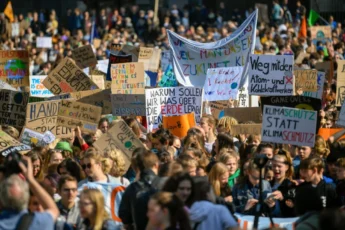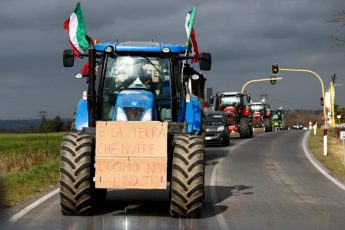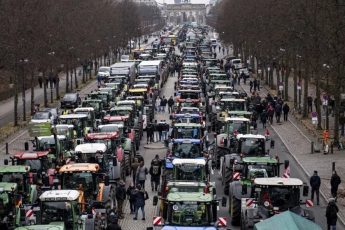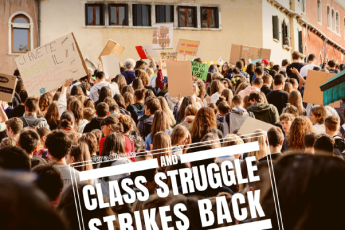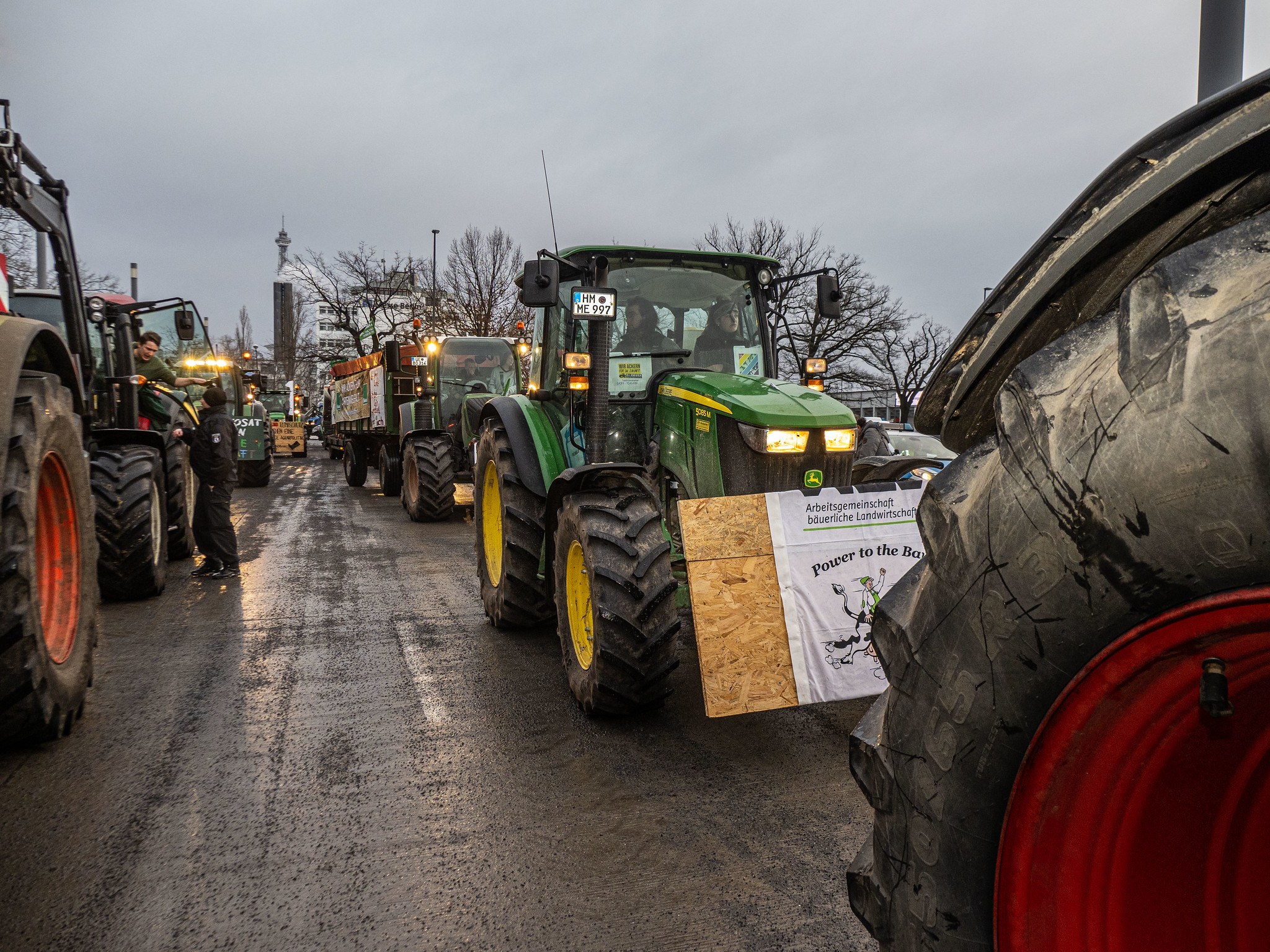
by MALTE BLUM
As Climate Class Conflict, we started a collective discussion on what the recent wave of farmers’ protests that spread throughout Europe in the past weeks can tell us about the green transition and the way it is changing in the context of war and economic recession. Last week, we published the first contribution, in which we tried to reflect on the protests starting from the acknowledgment that the undergoing transformation of the agricultural sector involves a process of industrialization that is having a crucial impact on the working and living conditions of million men and women, but also from the need to reject the alternative presented to us between a profit-led transition and the far-right’s anti-environmentalism. This second contribution, by Malte Blum, takes up the same problem from a specifically German perspective.
It’s mid-January. I’m sitting with an Italian comrade in a small bistro in Turin. We’re eating pannini and talking about politics when he says: “It’s interesting what’s happening in Germany right now, huh? It could be explosive. Maybe even trigger a wave of strikes, right?” He is confused by my skeptical look. “Maybe. Unfortunately everyone cares, apart from the left in Germany,” I say and bite into my panino.
Early February, French farmers storm a wholesale market near Paris, barricades burn in Brussels, farmers all over the EU from Germany to Greece protest against rising taxes, subsidy cuts and environmental regulations. Many farmers feel left alone, fear for their livelihoods and demand more appreciation and support. Meanwhile, the German left is caught between overwhelmed apathy, sincere solidarity and a legitimate need for distancing. After all, there are good reasons in Germany to stay away from the farmers’ protests: right-wing symbols, slogans and references at demonstrations, open hatred against a so-called left-wing green establishment and a conservative farmers’ association that fails to distance itself credibly and consistently from the far-right. Not an easy and comfortable environment for left interventions, but far from all farmers are open to right-wing agitation. Furthermore it would be fatal to leave an issue that is fundamental for just futures, such as agriculture and nutrition, to right-wing and conservative power of interpretation and organization. After a closer look, it quickly becomes clear that the farmers’ protests in Germany and elsewhere are about much more than just cutting subsidies for agriculture and partial environmental regulations. Rather the farmers’ struggles are actually paradigmatic of the crises of our time and are about nothing less than the question of how we can shape our living, working and production conditions in a socio-ecologically equitable way. In order to get to the core of the problem, it is important to question who is actually being taken money from and who is not. As well as who or what are agricultural structures intended for and who or what are they not intended for? And who benefits from them and who does not? Moreover, it is about to show who is responsible for the ecological transformation of agriculture and who actually bears this responsibility at present, as well as the interests and actors behind different claims.
In fact, around a third of the EU budget flows into European agriculture in various ways. In Germany, the industrialization of agriculture has been driven forward in recent years and agricultural structures have been liberalized. While growth, competition and dumping prices dominate the sector, peasants are at the forefront of this development, while subsidies mainly favor large farms and agri-food corporations. The anger and despair that is currently being unleashed in the protests reveal conflicts that are coming to light on various levels and exposing deep cracks in the capitalist class. While at the time of neoliberal globalization there was still something of a consensus on exploitation, the capitalist class is increasingly divided over their ideas for the future of this world. Regarding the farmers’ protests, the disputes between liberal proponents of a green transition and reactionary proponents of fossil authoritarianism are particularly apparent. The former propagate contradictory economic restructuring processes as unavoidable and hide the interests of their class behind the mantra that climate protection can only be achieved through capitalist commodity production, economic growth and securing prosperity. These liberal dreams of maintaining the free market on the way to a net-zero high-tech Eldorado are increasingly revealing their unrealizability due to limited resources, energy, workforce and their own market logics. So what remains are unrealistic austerity politics under the banner of the green transition, which prove to be isolated symptom-fighting and policies aimed at individualistic and market-based solutions that are socially unjust and ecologically ineffective.
All of this is grist to the mill of conservatives and reactionaries who are once again able to pose as saviors of the “little man” and protectors of freedom and security. In doing so, they are instrumentalizing and channeling legitimate fears of various social groups to achieve their goals: cementing the fossil fuel and Roundup®-based status quo. In their fight for business as usual, a wide variety of actors are joining forces, in this case, agrobusiness, food industry, large landowners, right-wing to conservative politicians and leading agricultural and forestry organizations. Meanwhile, they are creating a climate of hatred and fear not only against the green transition, but against everything progressive. They try to distract with lies and false trails from the fact that it was precisely their policies of neoliberal industrialization and globalization that created the agrarian structures in Germany and elsewhere that are at the heart of the problem: lots of land in the hands of a few, orientation towards global markets, dumbing prices and subsidies that benefit the biggest players the most. While liberal environmental regulations and subsidy cuts do not lead to more climate and environmental protection, but to more inequality and capital concentration in agriculture, business as usual will increase the climate crisis immeasurably. That is why it is exactly these cracks that need to be intervened in to highlight the class and interest contradictions that become visible in them.
For a transnational left, this means showing that liberal and reactionary promises for the future are based on precarious security and only produce selective and temporary freedoms. This requires a broad discussion about which agricultural structures and forms of farming are desirable and socio-ecologically equitable and which working and living conditions and structures make this impossible. Thereby, it is important to keep in mind that in the context of the green transition and its austerity policies, farmers can rely on a strong representation of their interests and support among the population, while the precarity of workers, migrants and landless people remains invisible in this context. While the green transition aims to secure the profits and interests of capitalists in the face of ecological and social upheaval, those who will and are already bearing the costs are the working class and all marginalized and precarious people and groups. After all, they are the same agricultural structures and regulations that put pressure on farmers and create dumbing prices, in which the exploitation of workers is embedded and required. Whether the organic tomato from Spain, the asparagus from German fields, or the trucking of agricultural products across Europe, they are based on the exploitation of labour force. Accordingly, it is important to show that both the austeritarian green transition and the continuation of the prevailing agricultural structures are neither in the interests of small farmers nor in the interests of all people. Instead, one must be exposed as a liberal illusion and the other as an authoritarian scam, which are both carried out on the backs of workers, peasants, indigenous communities, migrants and all other precarious people.
To do so, we do not have to start from scratch, but can build on the work from comrades, peasants, workers, indigenous people and many more who have been fighting for social-ecological just agricultural structures around the world for decades. Whether it is the AbL (Arbeitsgemeinschaft bäuerliche Landwirtschaft) in Germany, an association of farms that work together for social and ecological agriculture, the demonstration alliance “Wir haben es satt!”, which has been taking to the streets in Berlin for more than 10 years for a peasant and ecological agriculture, the French farmers’ union Confédération paysanne, or La Via Campesina, an international alliance of small farmers, agricultural workers and landless people with all their sub-organizations, to name just a few. We can build on these experiences to use the dissent in the capitalist class to create synergies and gather strength by politicizing their contradictions. This means bringing diverse contexts together, approaching different people, inviting them and accepting invitations, engaging in uncomfortable discussions and processes outside of comfort zones, as well as thinking about and initiating new alliances. In short, to create spaces where people can look around to see who is on the same side of the barricade and who is not. At the end of the day, it’s about listening to and showing understanding for those working on the front lines of the climate crisis and who make an important contribution to climate protection every day through their work in agriculture, whether they are peasants, workers, landless or migrants, or all of these together.


